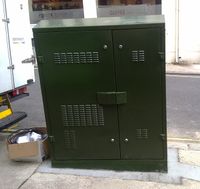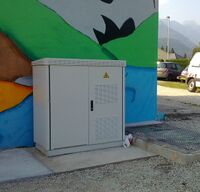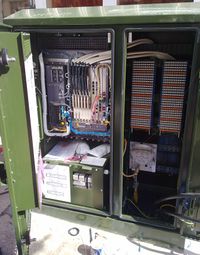Tag:telecom=service_device
| Description |
|---|
| Active equipment which deliver service to connected customers. It can be for instance a DSLAM, a telephone switch, or more recently an OLT for optical networks. It excludes amplifiers or repeaters installed along local loops or long distance lines. |
| Group: telecom |
| Used on these elements |
| Useful combination |
| Status: approved |
| Tools for this tag |
|
Service devices are active equipment which deliver service to connected customers. It can be for instance a DSLAM, a telephone switch, or more recently an OLT for optical networks. It excludes amplifiers or repeaters installed along local loops or long distance lines as they not deliver a service.
This value isn't intended to extensively define how service devices work, since it's a complex topic and not so relevant for OSM.
Such service devices are usually installed in telecom exchange buildings, but they can also sometimes be installed outdoor, in standalone street cabinets. This may be because of a lack of physical space in exchange buildings, or to increase data rates in suburbs areas by shortening the length of the copper local loop.
If a cabinet is described with this value, it must only contains service devices without a distribution frame, otherwise they turn into an actual telecom=exchange in a cabinet. Furthermore, a service device cabinet does not create a new local loop: it simply serves a subset of customers on an existing local loop, and connects back to an upstream telecom exchange building.
A service device cabinet usually makes fan noise and heat as it's always an active equipment provided with electricity.
Tagging
| Key | Value | Description | Use |
|---|---|---|---|
| telecom=* | service_device | mandatory | |
| telecom:medium=* | copper or fibre mainly | Depend on which technology the service is delivered to customers | mandatory |
| man_made=* | street_cabinet | If the service device is inside a street cabinet | recommended |
| utility=* | telecom | The corresponding street cabinet is mainly intended for telecom networks | recommended |
| operator=* | <operator> | The name of the company that operates the cabinet. | recommended |
| owner=* | <owner> | The name of the organization which has the ownership of the cabinet (State or local administrative organization for example) | recommended |
| ref=* | <reference> | Device cabinet (several devices can be in a single cabinet) reference as seen in situation | recommended |
Possible tagging mistakes
Examples
| Photo | Tagging | Note |
|---|---|---|
 |
man_made=street_cabinet
|
Such cabinets are usual in England, operated by openreach and installed next to local loop connection points. They host dslam nearer from subscribers as to increase their transmission rate over xDSL connections. |
 |
man_made=street_cabinet
|
French telcos also use such cabinet to host active equipment outside of overloaded buildings. Here a DSLAM provide service to subscribers connected to the telecom exchange building behind. No patch panel is inside the cabinet, subscribers lines are reached directly in the building distribution frame. |
